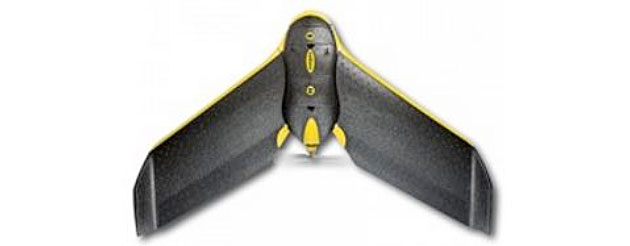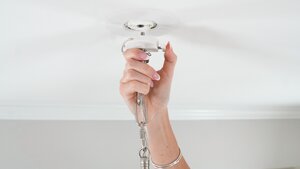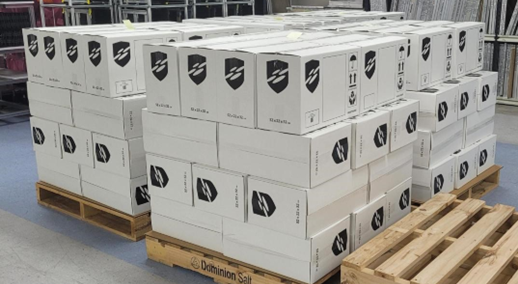A Brief History of Drones
Unmanned aerial vehicles (UAVs), or drones, have been around for the better part of a century, but it wasn't until the early 1990s that drones entered the popular lexicon, mostly through their use in stealth military applications.
The first "drone" (named for making a sound similar to a male bee) was actually a boat. Introduced at an exhibition at Madison Square Garden in 1898, inventor Nikolas Tesla used voice commands (actually radio frequencies) to make the unmanned small vessel change direction, to the delight of the audience. Unmanned aircraft were subsequently used by the United States during World War II to train anti-aircraft gunners, and in Germany, which invented a 2,300-pound bomb called "Fritz X," with four small wings and a radio controller.
Early uses of drones for military applications have morphed into a stunning and growing array of commercial uses. Among industries taking an active interest in drones, infrastructure is the most prominent, followed by agriculture, according to a recent PwC report, with respective market values of $45.2 billion and $32.4 billion. Drones are also being used in transportation, insurance, media and entertainment, telecommunications, security and mining. GE has recently begun testing drones and robotic "crawlers" to inspect refineries, factories and other industrial sites, aiming to capture a slice of a global drone inspection market pegged at $40 billion.
Drones in Ag
One of the most interesting and potentially lucrative uses of drones is in agriculture, where drones can assist farmers in gaining better intelligence about their farms, thus reducing input costs and increasing crop yields (and profits).
While the US Department of Agriculture collects a plethora of agricultural data from farmers—such as crop emergence estimates—the raw data is recognized as having limited value. The industry is beginning to understand that in order to move forward in refining its data, it needs to capture it faster, using real-time information technology.
Drones, loaded with high-resolution point and shoot cameras, thermal imagery, geographic information systems, flight pattern software and GPS, are going to help drive an era of "data-driven" agriculture.
Deveron UAS
Deveron UAS Ltd. (DVR.CSE), an Ontario-based drone service company, is taking the technology to new heights, pun intended, with a fleet of drones it is using to gather and analyze data for farmers—all packaged in a compelling business model that features a constant revenue stream and a massive opportunity for growth.
Founded by David MacMillan, a specialist in public venture capital, and Norm Lamothe, an entrepreneur with a background in aviation and farming, Deveron was started four years ago from a venture investment company named Greencastle Resources (TSX.V:VGN), which is Deveron's largest shareholder. MacMillan recognized the value of data in agriculture as a large market with huge upscale potential, and combined with drones, saw a business opportunity. He pitched Lamothe on Eagle Scout Imaging, then the largest company in Ontario using drones to collect farm data. In 2015 Deveron acquired Eagle Scout, and the new entity was on its way to full-scale deployment of drones across farms in Ontario, beginning last year.
"We really saw the ability of drone data to drive a very important value proposition for a farmer, which is increasing yield and reducing cost, and we saw the idea of creating a network of drones to allow the everyday farmer to large enterprises, to look at drone data without having to take any technology risk," MacMillan said in a recent interview with Ahead of the Herd. By technology risk, he is referring to the costs and hassle involved in acquiring drones for agricultural survey work—everything from knowing which sensors to use, to understanding the regulations around drone use, to finding operators to fly them. "It seemed like a perfect service business that most big guys in ag weren't going to want to try to conquer."
3 Ways Drones Can Help Farmers
Deveron's data-gathering operation is fairly straightforward. Using eBee drones from senseFly, a European drone maker, sensors placed inside the drones collect crop data mainly through remote sensing technology called NDVI, which stands for normalized difference vegetation index. The data is then uploaded to a computer, and thousands of images are stitched together into what is known as a shapefile. The shapefile is plugged into the agricultural software the farmer is using, and the information is ready for analysis.
Arguably one of the most valuable uses of drones in agriculture is to perform more effective seed and fertilizer applications. Rather than applying a uniform amount of fertilizer across the entire crop, drone data can identify where plant emergence levels are low, and fertilize accordingly, spreading more product on the plants that need it most. Drone mapping can also help farmers to perform variable seeding, based on soil analysis, and guide them where they need to replant certain areas.
Second, in the event of crop failures resulting from disease, pests or weather events, drones add valuable information both for deciding where to apply fungicides and for crop insurance purposes. Where a farmer might spray a field once every 10 years to prevent white mold in soybeans, for example, drone data can identify susceptible areas, and spray those areas rather than the whole crop. If a crop is ruined, it's usually a gray area as to what percentage of the crop was damaged and whether the crop can be saved or should be replanted. Drone data can allow the farmer to make the decision based on accurate data, not educated guesses, and can also be used by insurance companies.
The last, and perhaps most exciting use of drone data is how it can help farmers to predict yields. Data from drones flown over a field in July can be correlated with actual numbers off the combine, allowing farmers to know far in advance of harvest what kind of crop yield they will get. Another tool for predicting yields is using a drone to fly the field after plant emergence to determine emergence levels—something impossible for a farmer to do unless he actually walks each acre.
"This is the first time where someone can say, 'We have missed emergence over 18 acres in a 150-acre block, so there's a huge amount of yield at risk because we're not going to have any corn,'" says MacMillan.
Show Me the Money
All of these uses for agricultural drone data are interesting, but how do they help the farmer become more profitable? Deveron's "show me the money" proposition can be demonstrated by two case studies. In the first case, Deveron used drones to track a field of winter wheat, from planting in fall to emergence in spring, using NDVI images to determine areas of survivability in a region prone to winter kill. The drones determined that, based on a 30% survival threshold (any number greater than 30% warrants replanting) and input costs, at a 40% kill rate the farmer would have sustained a $5,000 loss if the crop was left in the ground.
In another example, a field of potatoes was planted in May and the drone flew the field in June. Using remote sensing, the drone determined that the grower could save 17 pounds per acre of calcium ammonium nitrate fertilizer across the entire field, thus providing the grower with a two-to-one return on investment.
Sky's the Limit
The collection of agricultural data through drone flights is certainly a new area, and one that a number of companies are likely to want to get in on the action. One of Deveron's key advantages is that it is one of the first Canadian companies to have national compliance to operate drones across Canada (within visual line of sight) under Transport Canada's UAV regulations.
In February Deveron announced that it had completed 500 commercial drone flights in 2016 and it plans, throughout the 2017 growing season, to add customers in Alberta, Saskatchewan and Manitoba—a potential market of 50 million acres. The company just signed a multiyear commitment to work with Thompsons Ltd., a major agricultural retailer in Ontario.
But in terms of total acreage potential, Deveron is looking at a chance to triple the amount of row crops (corn, soybeans, wheat, and cotton, etc. are called "commodity" or "row" crops) that could be flown by drones, by expanding into the United States. That would open up a market of 315 million acres versus 88 million in Canada. Last fall the company completed its first drone flight in the U.S.—an extensive survey covering almond and pistachio orchards in California.
For Deveron, the market is not only there, it's reoccurring. MacMillan said he sees most customers needing drone data twice a year, and at $3 to $5 an acre, the opportunity exists for a multimillion-dollar, recurring-revenue model. Add an expansion into the United States, and even beyond, and the sky really is the limit.
"We've identified that people will buy this data so it's a brand-new market and I think that's why it's exciting. If you start looking at the opportunity from a revenue perspective of collecting drone data across North America, it's a giant number," MacMillan said.
Conclusion
Because of Deveron UAS being a first-mover into a US$32 billion sector, because of massive global growth potential, and because the company is building a recurring revenue stream, Deveron should be on all Ahead of the Herd investors' radar screens.
Deveron UAS is definitely on my screen. Is it on yours? If not, it should be.
Richard (Rick) Mills, AheadoftheHerd.com, lives on a 160-acre farm in northern British Columbia. Richard's articles have been published on over 400 websites, including: WallStreetJournal, USAToday, NationalPost, Lewrockwell, MontrealGazette, VancouverSun, CBSnews, HuffingtonPost, Beforeitsnews, Londonthenews, Wealthwire, CalgaryHerald, Forbes, Dallasnews, SGTreport, Vantagewire, Indiatimes, Ninemsn, Ibtimes, Businessweek, HongKongHerald, Moneytalks, SeekingAlpha, BusinessInsider, Investing.com, MSN.com and the Association of Mining Analysts.
Legal Notice / Disclaimer
This document is not and should not be construed as an offer to sell or the solicitation of an offer to purchase or subscribe for any investment.
Richard Mills has based this document on information obtained from sources he believes to be reliable but which has not been independently verified.
Richard Mills makes no guarantee, representation or warranty and accepts no responsibility or liability as to its accuracy or completeness. Expressions of opinion are those of Richard Mills only and are subject to change without notice. Richard Mills assumes no warranty, liability or guarantee for the current relevance, correctness or completeness of any information provided within this Report and will not be held liable for the consequence of reliance upon any opinion or statement contained herein or any omission.
Furthermore, I, Richard Mills, assume no liability for any direct or indirect loss or damage or, in particular, for lost profit, which you may incur as a result of the use and existence of the information provided within this Report.
Richard owns shares of Deveron UAS (CSE:DVR) and DVR is an advertiser on his site.
Want to read more Streetwise articles like this? Sign up for our free e-newsletter, and you'll learn when new articles have been published. To see a list of recent articles and interviews with industry analysts and commentators, visit our Streetwise Interviews page.
Disclosures:
1) Rick Mills' disclosures are listed above.
2) The following companies mentioned in this article are sponsors of Streetwise Reports: None. Streetwise Reports does not accept stock in exchange for its services. Click here for important disclosures about sponsor fees. The information provided above is for informational purposes only and is not a recommendation to buy or sell any security.
3) Comments and opinions expressed are those of the specific experts and not of Streetwise Reports or its officers. The author is wholly responsible for the validity of the statements. The author was not paid by Streetwise Reports for this article. Streetwise Reports was not paid by the author to publish or syndicate this article. The information provided above is for informational purposes only and is not a recommendation to buy or sell any security. Streetwise Reports requires contributing authors to disclose any shareholdings in, or economic relationships with, companies that they write about. Streetwise Reports relies upon the authors to accurately provide this information and Streetwise Reports has no means of verifying its accuracy.
4) The article does not constitute investment advice. Each reader is encouraged to consult with his or her individual financial professional and any action a reader takes as a result of information presented here is his or her own responsibility. By opening this page, each reader accepts and agrees to Streetwise Reports' terms of use and full legal disclaimer. This article is not a solicitation for investment. Streetwise Reports does not render general or specific investment advice and the information on Streetwise Reports should not be considered a recommendation to buy or sell any security. Streetwise Reports does not endorse or recommend the business, products, services or securities of any company mentioned on Streetwise Reports.
5) From time to time, Streetwise Reports LLC and its directors, officers, employees or members of their families, as well as persons interviewed for articles and interviews on the site, may have a long or short position in securities mentioned. Directors, officers, employees or members of their immediate families are prohibited from making purchases and/or sales of those securities in the open market or otherwise from the time of the interview or the decision to write an article, until one week after the publication of the interview or article. As of the date of this article, officers and/or employees of Streetwise Reports LLC (including members of their household) own securities of Deveron UAS Corp., a company mentioned in this article.
Image courtesy of the author





































